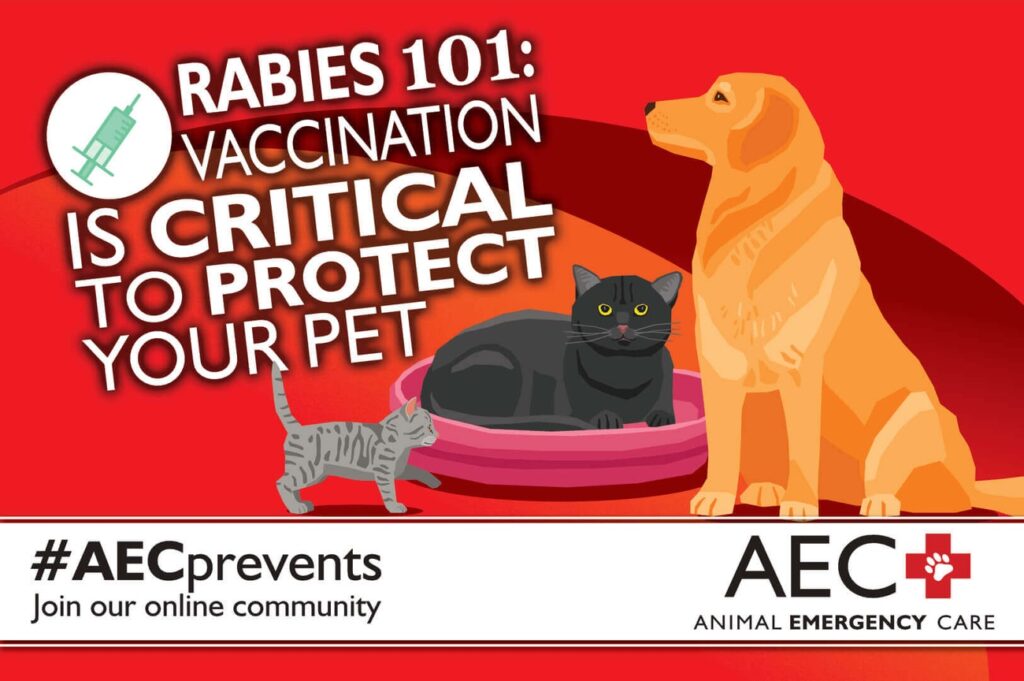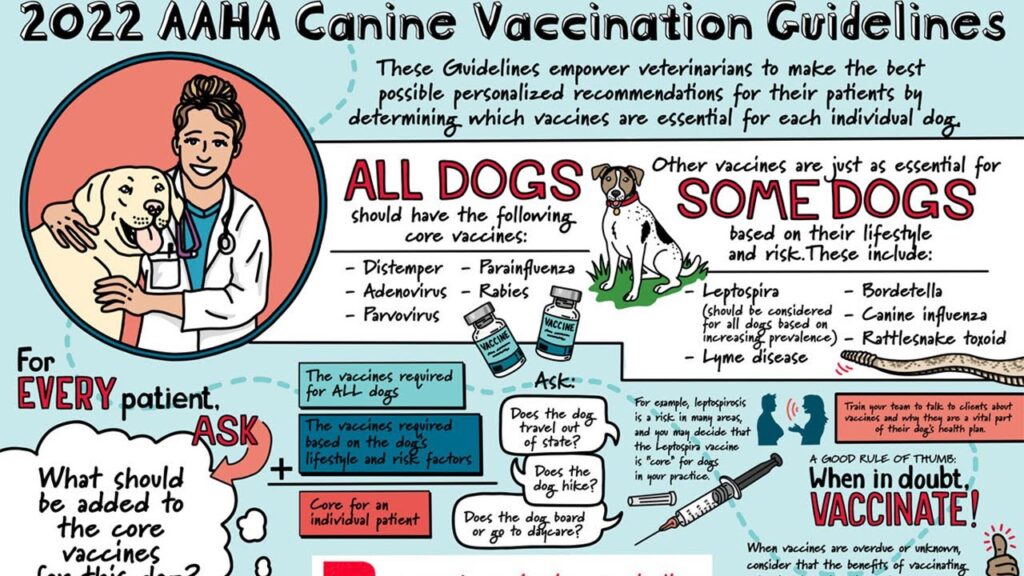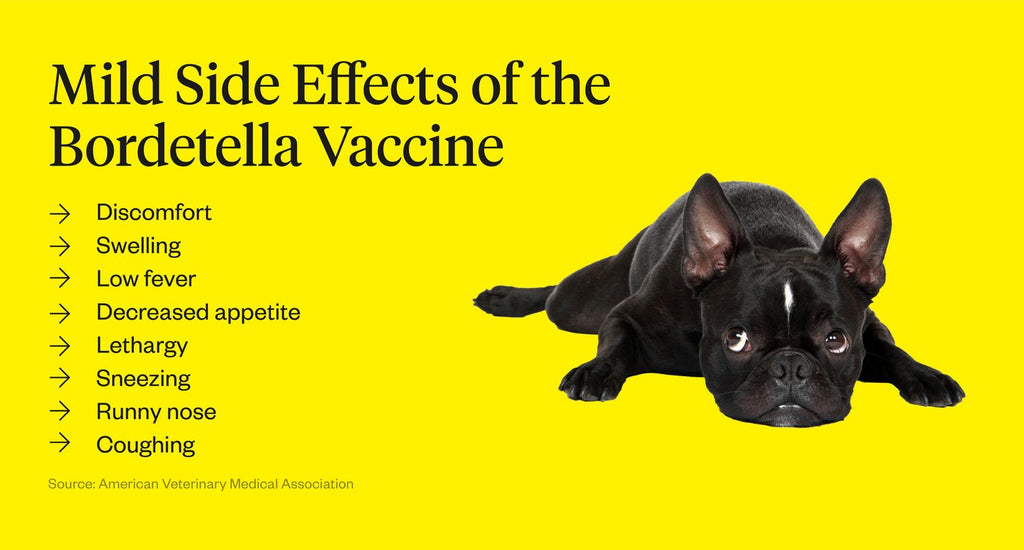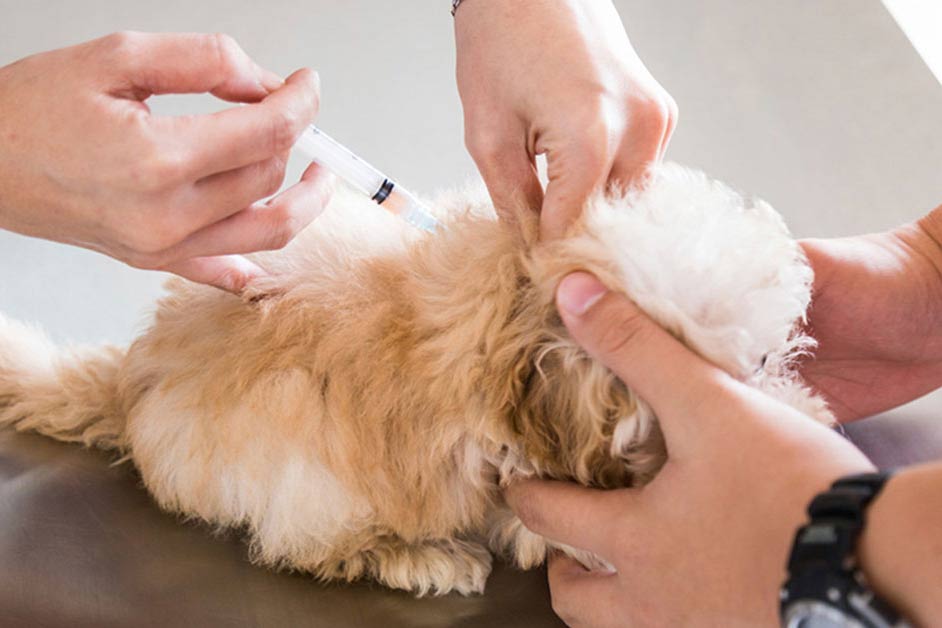Dog owners spend hundreds of dollars on toys and treats, yet many of us think twice about paying $75-150 yearly for essential vaccines. This small investment protects against diseases that could cost thousands to treat.
Most vaccines protect our dogs for 7 to 15 years, depending on the type. Core vaccines like rabies, parvovirus, distemper, and hepatitis are the foundations of every dog’s health plan. These vaccines work so well that diseases like distemper have become rare.
My work with many vets has helped me create this detailed guide on the most important vaccines for dogs in 2025. This piece will help you understand what your dog needs and why, whether you’re a new pet parent or just updating your dog’s vaccination schedule.

Image Source: Animal Emergency Care
The rabies vaccine is the only immunization legally mandated for dogs throughout most of the United States. This requirement exists because rabies remains a deadly zoonotic disease that kills almost 100% of its victims once symptoms show up.
Understanding Rabies and Its Severity
Rabies attacks infected mammals’ central nervous system and brain. The disease spreads through direct contact with infected animals’ saliva, usually from bites or scratches. Dogs used to be the biggest source of human rabies transmission worldwide, causing up to 99% of all human rabies cases.
Vaccination programs have cut down cases by a lot. The CDC reports that lab-confirmed rabies cases in dogs dropped from 8,000 in 1947 to just 132 in 1983. The United States managed to keep the canine rabies virus variant at bay through vaccination and stray dog control programs by 2008.
Wild animals like bats, skunks, raccoons, and foxes still pose a threat. These animals keep the virus alive and put unvaccinated pets at risk.
Legal Requirements Across Different States
American state laws about rabies vaccination differ in many ways. Right now, 39 states require dogs to get rabies shots, while 34 states make it mandatory for cats. Yet 11 states don’t have any statewide rules about rabies vaccination.
Most places need puppies to get their original vaccine at 3-4 months old. States also have different rules about who can give the vaccine. Some states only allow licensed vets to do it, while others let vet techs give shots under supervision.
Only 18 states out of 50 allow medical exemptions for dogs with health issues. Vets in these states can give waivers to seriously ill or immune-compromised dogs since rabies vaccines work best in healthy animals.
Breaking these vaccination rules can lead to serious consequences. Your unvaccinated dog might face a 4-6 month quarantine or even euthanasia if another animal bites it.
Duration of Immunity and Booster Schedule
Research shows that rabies vaccines protect dogs way beyond their labeled duration. A study with research beagles showed that 80% of vaccinated dogs lived through exposure to the rabies virus after 6 years and 7 months.
The standard vaccination schedule looks like this:
- First shot at 3-4 months old
- Booster shot after a year
- More boosters every 1-3 years based on state law and vaccine type
That one-year booster serves a vital purpose – it protects any dogs that didn’t respond to their first shot. Vets say a dog needs 28 days after its first rabies vaccine to be “currently vaccinated”.
Your dog becomes “overdue” if it misses a scheduled booster by even one day. This status changes how officials handle your pet’s exposure to potentially rabid animals.
Potential Side Effects and Risk Assessment
Rabies vaccines usually cause mild, short-term side effects such as:
- Slight fever
- Less appetite
- Lower energy for 24-36 hours
- Tender or slightly swollen injection site
These mild symptoms show that the vaccine works by getting the immune system going. Some dogs get a small, painless bump at the injection site that lasts a couple of weeks.
Serious reactions happen rarely, showing up minutes to hours after the shot. Watch for hives, vomiting, diarrhea, facial swelling, severe injection site pain, coughing, or collapse. Rush to an emergency vet if you notice these serious signs.
The benefits of vaccination are nowhere near the tiny risk of side effects. Since rabies kills almost everyone it infects and threatens public health, the protection from this deadly disease outweighs the small chance of side effects.

Image Source: American Animal Hospital Association – AAHA
Distemper vaccines aren’t legally required like rabies shots, but they remain one of the most important vaccines for dogs throughout their lives. This nasty virus attacks multiple body systems at once, making it a devastating and often deadly disease.
How Distemper Affects Dogs
Canine distemper virus (CDV) is a paramyxovirus closely related to measles and rinderpest viruses. The virus first multiplies in the respiratory tract’s lymphatic tissue before launching an all-out attack on the entire lymphatic system, respiratory tract, gastrointestinal tract, urogenital epithelium, central nervous system, and optic nerves. This widespread invasion makes distemper extremely dangerous.
Dogs with distemper show symptoms that follow a typical pattern, which varies based on how far the infection has spread:
- First signs include fever, nasal discharge, eye discharge, lethargy, coughing, and breathing problems
- The disease then causes vomiting, diarrhea, and loss of appetite
- Later stages bring neurological problems like muscle twitches, seizures, circling, head tilt, and partial or complete paralysis
Dogs who catch distemper face a roughly 50% chance of dying. Survivors usually end up with permanent nerve damage that can’t be fixed. People call it “hard pad disease” because some dogs’ noses and footpads become thick and hard.
Latest Advancements in Distemper Vaccines for 2025
Vets agree that distemper vaccines are “core” – they’re essential for all dogs, whatever their lifestyle or location. These vaccines stand among those absolutely necessary for dogs in 2025.
Today’s distemper vaccines come in several forms:
- Modified-live virus (MLV) vaccines
- High-titer, low-passage modified-live virus (less attenuated)
- Recombinant canarypox vector vaccines with targeted CDV genes
Scientists now focus on tackling key challenges in vaccine development: virus development, immune evasion, and cross-species transmission. New technologies show promise, like nanoparticle-based vaccines that deliver viral antigens better and trigger stronger immune responses. Oil-based formulations are also improving how well these vaccines work, especially in terms of immunogenicity.
These improvements matter because distemper remains dangerous even with vaccination. Vets have seen more distemper cases over the last several years, possibly due to missed vaccinations or vaccine failures.
Duration of Protection and Booster Recommendations
Puppies need their first distemper shot at 6-8 weeks old. They get more shots every 2-4 weeks until they’re at least 16 weeks old. This schedule works around the mother’s antibodies, which can block vaccines until they naturally decrease around 12-14 weeks.
After the puppy shots, dogs need a booster within one year. Most experts then suggest boosters every three years instead of yearly shots. Research backs this up – one study showed dogs stayed protected against distemper for 55-57 months (over 4.5 years) after their first shots.
The three-year schedule has become standard, but some vets recommend more frequent boosters based on local disease risks. A study of antibody levels suggests boosters every two years might work better to keep all dogs protected.
Distemper’s devastating nature and its presence in wildlife like foxes, raccoons, and skunks make current vaccinations vital. This becomes even more important since we can’t cure distemper – vets can only treat the symptoms once a dog gets infected.
Dogs that can’t get vaccines for health reasons need extra protection. Keeping them away from potentially sick animals, including wildlife, becomes their main defense.
Image Source: American Kennel Club
Parvovirus ranks among the deadliest threats to unvaccinated dogs and can kill them within 48-72 hours after symptoms show up. This highly contagious virus spreads faster than many other canine diseases. It’s tough enough to survive for months outside an animal’s body, even in winter conditions.
Why Parvovirus Remains a Serious Threat
The virus attacks white blood cells and the dog’s gastrointestinal tract. This causes severe vomiting and bloody diarrhea that quickly leads to dehydration. Dogs without treatment face grim odds – only 9% survive. The good news? Proper veterinary care raises survival rates to 60-90%.
In spite of that, the virus’s amazing ability to persist makes it an ongoing threat. Most household cleaners can’t kill parvovirus, and it stays active in soil and on surfaces for long periods. Yes, it is true that infected dogs release so much virus that any place they touch could stay infectious for months. Since most places (including dog parks and homes) don’t get regular bleach treatment, unvaccinated puppies risk exposure almost everywhere.
High-Risk Dogs and Situations
The virus can infect any dog, but some groups face substantially higher risk. Puppies aged 6 weeks to 6 months are most at risk. We noticed this happens because protection from their mother’s antibodies fades during this time.
Some breeds show greater risk:
- Rottweilers and Doberman Pinschers
- German Shepherds
- American Pit Bull Terriers/Staffordshire Terriers
- Labrador Retrievers
- Bull Terrier breeds
Note that dogs without complete vaccination face higher risk, whatever their breed. On top of that, socializing in public spaces or puppy classes becomes dangerous when not all dogs’ vaccination status is confirmed.
Modern Vaccine Formulations and Efficacy
Today’s parvovirus vaccines mostly come as modified-live virus (MLV) formulations. These work better than killed vaccines at building immunity. Without doubt, these vaccines work well, turning parvovirus from a constant threat into an occasional concern.
Vaccination starts at 6-8 weeks old, with boosters every 3-4 weeks until 16 weeks. Dogs need another shot at one year, then every three years after that. This schedule helps deal with maternal antibodies that might block the vaccine’s effects until they naturally decrease.
Your puppy needs the full vaccination series. Partial protection might not build enough immunity, leaving dogs open to infection. Protection kicks in about four weeks after the final shot.
Cost vs. Treatment: The Economic Argument
The numbers make a strong case for vaccination. Each vaccine dose costs $20-45, with the full puppy series running $60-180. Compare this to parvovirus treatment, which costs $500-2,000 on average. Severe cases needing longer hospital stays can reach $8,000.
Money isn’t the only concern. Treatment takes a toll on dogs. They need IV fluids to fight dehydration, medicine to control vomiting and diarrhea, antibiotics for other infections, and sometimes even blood transfusions.
Prevention costs nowhere near as much as treatment. Vaccination offers the most humane and economical way to protect dogs from this devastating disease. As one of the core vaccines dogs need, parvovirus shots are essential for responsible pet owners, whatever their location or lifestyle.

Image Source: American Animal Hospital Association – AAHA
Your dog needs several core vaccines, and the adenovirus vaccine deserves more attention than it gets. This vaccine protects against a deadly disease. Veterinary associations worldwide recognize the Canine adenovirus type 2 (CAV-2) vaccine as a core vaccine. It gives cross-protection against canine adenovirus type 1 (CAV-1), which causes infectious canine hepatitis.
Understanding Canine Infectious Hepatitis
CAV-1 caused infectious canine hepatitis (ICH), a severe and often deadly disease in canids. This virus attacks the liver and leads to inflammation with serious complications. ICH has become uncommon thanks to widespread vaccination. Yet sporadic cases still pop up, which shows why protection remains crucial.
Dogs catch the virus through direct contact with infected materials. These include urine, nasal discharge, and eye secretions from sick animals. The virus poses a special risk because it stays active in the environment. Adenoviruses resist chemical and physical agents remarkably well, so they survive outside the body for long periods.
Symptoms range in severity based on the dog’s age and immune response:
- Mild cases: poor appetite, depression, mild fever, and possible cloudiness in one or both eyes (“blue eye”)
- Severe cases: stomach pain, vomiting, diarrhea, fluid buildup under the skin, and jaundice—young puppies often die
Combined Vaccines vs. Individual Administration
Most vets give the CAV-2 vaccine as part of combination vaccines with other core components. These combination products usually include:
- Distemper virus
- Parvovirus
- Parainfluenza virus
- Sometimes leptospirosis
Studies show strong antibody responses when dogs get these vaccine components together. One study found that giving leptospirosis vaccine with distemper, adenovirus, and parvovirus vaccines led to lower titers after a year. The levels stayed above protective thresholds though.
Vets can give CAV-2 two ways:
- Parenteral (injectable) – Most common, follows distemper and parvovirus schedule
- Intranasal – Puppies as young as 3 weeks can get this with parainfluenza and Bordetella vaccines
Duration of Immunity and Current Protocols
CAV-2 vaccination follows the same schedule as distemper and parvovirus. The typical protocol looks like this:
- Original vaccination at 6-8 weeks
- More doses every 2-4 weeks until 16-20 weeks
- Booster within one year after last puppy vaccine
- More boosters every 3 years after that
Vets now see that immunity from modified live virus CAV-1 vaccines lasts 7 or more years. The 2006 American Animal Hospital Association Canine Vaccine Task Force Report backed up this long-lasting protection.
Vets prefer modified live CAV-2 vaccines over older CAV-1 vaccines because they cause far fewer bad reactions. The older CAV-1 vaccines often led to serious problems like interstitial nephritis and “blue eye” (corneal edema).
Today’s CAV-2 vaccines give great cross-protection against CAV-1 and are much safer. They prevent both infectious hepatitis and help reduce breathing problems from CAV-2 infection.
Adenovirus vaccination stands as one of the absolutely necessary vaccines for dogs. It joins rabies, distemper, and parvovirus as core vaccines that all dogs need, whatever their lifestyle or location.

Image Source: CDC
Leptospirosis vaccination has become a core vaccine for all dogs. This marks a radical alteration from its previous status as a lifestyle-based or regional vaccine. The change comes from our better understanding of how common this disease is and what it means for both pets and humans.
Zoonotic Potential: Protecting Your Family
Leptospirosis stands out from other canine diseases because of its zoonotic nature—it can spread from animals to humans. This bacterial infection puts everyone in your household at risk. Dogs with the infection pass leptospires through their urine, which creates a path for transmission to family members.
The disease’s ability to spread between animals and humans makes it a crucial factor to think about when deciding which dog vaccines are absolutely necessary. Your dog’s vaccination reduces human exposure risk by a lot. Vaccinated dogs create a vital barrier between wildlife carrying the disease and human populations.
Dogs and humans catch the infection through contact with infected animals’ urine or contaminated water sources. A simple walk through puddles or standing water could lead to transmission.
Geographic Distribution and Risk Assessment
Leptospirosis now affects dogs everywhere, not just in rural areas. The risk extends to small breed dogs in cities, puppies as young as 11 weeks, older dogs, and rural pets alike.
The disease shows up more in:
- Wet and warm regions with higher rainfall
- Areas that flood or have standing water
- Places with wildlife like raccoons, skunks, rats and opossums
Studies have shown different risk levels across the United States. The Midwest, East, and Southwest show higher predicted probabilities for positive test results. This growing reach has led vet experts to update their vaccination guidelines.
Advances in Multi-Strain Coverage
Today’s leptospirosis vaccines work better and are safer than ever. The four-serovar vaccine protects against Canicola, Grippotyphosa, Icterohaemorrhagiae, and Pomona strains. This gives broader protection compared to earlier versions.
Research shows these vaccines help fight other serovars beyond the ones listed. Your dog gets more protection than what’s written on the label.
Dogs need an original shot plus a booster 3-4 weeks later, followed by yearly shots. This schedule keeps immunity strong since protection lasts about a year.
Weighing Benefits Against Potential Reactions
The old leptospirosis vaccine had a bad reputation for causing more reactions than other vaccines, which made many vets and pet owners nervous. Modern versions have a much better safety record.
New studies that look at vaccine side effects found similar reaction rates between leptospirosis vaccines and other core vaccines like distemper-parvovirus or rabies. Pet owners report adverse events in about 53 out of 10,000 vaccinations (0.53%).
Most reactions are mild and go away quickly without treatment:
- Fever
- Temporary lethargy
- Digestive upset
- Minor injection site swelling
The disease can cause kidney failure, liver failure, and death in 10-15% of infected dogs even with treatment. This makes the small risk of vaccine reactions worth the protection it provides.
Major vet organizations, including the American College of Veterinary Internal Medicine (ACVIM), now recommend leptospirosis vaccination for all dogs whatever their breed or lifestyle. This change from optional to necessary vaccine for dogs shows both the vaccine’s improved safety and our recognition of how widespread this disease has become.

Image Source: Dutch
Bordetella vaccination belongs to the lifestyle-based category, unlike the core vaccines we talked about earlier. Dogs that hang out with other canines need this shot. Pet owners often ask about necessary vaccines for dogs, and Bordetella’s importance really depends on their dog’s social life.
Understanding Kennel Cough and Its Transmission
Kennel cough, which experts call canine infectious respiratory disease complex (CIRD), happens when Bordetella bronchiseptica bacteria team up with viruses like parainfluenza, adenovirus, and influenza. This condition spreads faster in places where dogs gather through:
- Coughs and sneezes that release respiratory droplets
- Dogs touching each other
- Shared water bowls or toys
Dogs with kennel cough make a harsh, honking sound. You might also notice nasal discharge, sneezing, and tiredness. Some dogs get a fever too. Healthy adult dogs usually recover well, but puppies and older dogs could develop life-threatening bronchopneumonia.
Intranasal vs. Injectable Options
Pet owners can choose from three types of Bordetella vaccines:
The intranasal spray starts working within 48-72 hours. This quick protection makes it perfect for last-minute boarding needs. The spray builds immunity right where the infection tries to enter.
The injectable form works great for dogs that don’t like stuff in their nose, especially if they’re nervous or aggressive.
The oral vaccine works just as well as the nose spray. Studies show it can protect dogs for up to 13 months. Research found that one dose stopped coughing in all vaccinated dogs during a 13-month test.
Requirements for Boarding, Grooming, and Daycare
Every boarding facility, groomer, daycare center, and training class needs proof that your dog got the Bordetella shot. Most places want dogs vaccinated every 6 months. They also need the shot at least 48 hours before drop-off.
Duration of Protection and Timing Considerations
The vaccine’s protection lasts 6-12 months, depending on which type you choose. Some oral vaccines can work for up to 13 months. Vets suggest yearly shots for dogs that socialize sometimes, and twice-yearly boosters for frequent socializers.
For dogs with busy social lives, Bordetella ranks high on the list of most important vaccines for dogs. This isn’t because the disease is super dangerous, but because it spreads easily and facilities require it.

Image Source: AKC Pet Insurance
Dog owners now face a relatively new health concern – canine influenza. Many veterinarians have added it to their recommended immunization lists. Your dog’s risk level plays a significant role in deciding which dog vaccines are absolutely necessary for your pet’s health.
Rise of Canine Flu Strains in 2025
The United States has two dominant strains: H3N8 and H3N2. These strains spread easily and have caused recent outbreaks nationwide. The good news is that the death rate stays low at only 1-5%. The H3N2 strain can sometimes jump between species, and cats have caught this strain from sick dogs.
High-Risk Environments and Activities
Social settings pose the highest infection risk to dogs. Vaccination becomes vital for pets that visit dog parks, grooming facilities, boarding kennels, daycare centers, or join dog events. The virus proves hard to contain because infected dogs stay contagious for about a month. Dogs can catch and spread the virus without showing any signs.
Bivalent Protection Against H3N2 and H3N8
The development of bivalent vaccines marks a major breakthrough in canine health. These vaccines protect against both strains at once. Like human flu shots, they might not stop infection completely but they substantially reduce how sick dogs get and for how long. The vaccine helps the immune system identify and curb the virus if exposure happens.
Vaccination Timing for Maximum Effectiveness
The vaccination schedule needs careful timing to work best. Dogs require:
- Two original injections given 2-4 weeks apart
- Annual boosters after that
Protection doesn’t start right away—it kicks in about 14 days after the second shot. Pet owners should plan ahead and get their dogs vaccinated at least three weeks before any possible exposure.
The canine influenza vaccine hasn’t made it to the core vaccine list yet. However, it has grown more important for social dogs whose daily activities put them at higher risk of exposure.
Comparison Table
| Vaccine | Legal Status/Classification | Protection Against | Duration of Immunity | Original Vaccination Schedule | Risk Level/Mortality Rate | Notable Side Effects |
|---|---|---|---|---|---|---|
| Rabies | Legally Mandatory | Fatal viral disease that affects the nervous system | 5-7 years (required by law every 1-3 years) | First dose at 3-4 months with a booster after 1 year | Almost 100% fatal after symptoms appear | Mild fever, poor appetite, swelling at injection site |
| Distemper | Core Vaccine | Viral disease affecting respiratory, GI, and nervous systems | 3-4.5 years (boosters every 3 years) | Starts at 6-8 weeks with boosters every 2-4 weeks until 16 weeks | 50% death rate without vaccine | Not listed |
| Parvovirus | Core Vaccine | Severe stomach and intestinal virus | 3 years after first series | Begins at 6-8 weeks with boosters every 3-4 weeks until 16 weeks | 91% fatal without care; 10-40% with treatment | Not listed |
| Adenovirus/Hepatitis | Core Vaccine | Liver infection and breathing problems | 7+ years (boosters every 3 years) | Starts at 6-8 weeks with boosters every 2-4 weeks until 16-20 weeks | Often deadly in young puppies | Minimal with modern CAV-2 vaccines |
| Leptospirosis | Core Vaccine (Regional) | Bacterial infection that affects kidneys and liver | 1 year | First shot plus booster 3-4 weeks later | 10-15% fatal even with treatment | 0.53% adverse reactions |
| Bordetella | Lifestyle-Based | Kennel cough respiratory infection | 6-12 months | Single dose (varies by type) | Rarely deadly in healthy adult dogs | Not listed |
| Canine Influenza | Recommended for Social Dogs | H3N8 and H3N2 flu strains | 1 year | Two doses 2-4 weeks apart | 1-5% death rate | Not listed |
Conclusion
Dog owners in 2025 need to learn about seven significant vaccines. Each vaccine plays a unique role in keeping dogs healthy. Rabies shots prevent fatal disease. Distemper protects multiple body systems. Parvovirus guards against deadly gut problems, while adenovirus keeps the liver working properly. A dog’s leptospirosis vaccine protects both pets and their families. Dogs that socialize need Bordetella and canine influenza shots too.
Preventing disease through vaccines costs by a lot less than treating sick pets. The math makes this a no-brainer. Annual vaccine series run about $200-400, but treating one case of parvovirus can cost $8,000. Smart pet owners know vaccines are good for their dog’s health and their wallet.
These vaccines have solid safety records and rarely cause bad reactions. Different vaccines need different timing and boosters. Your vet can help create the right schedule based on your dog’s age, lifestyle, and risk factors.
These shots ended up protecting more than just your dog – they keep all dogs in the community healthy by stopping diseases from spreading. Regular shots and proper vet care give our furry friends their best shot at a long, healthy life.

